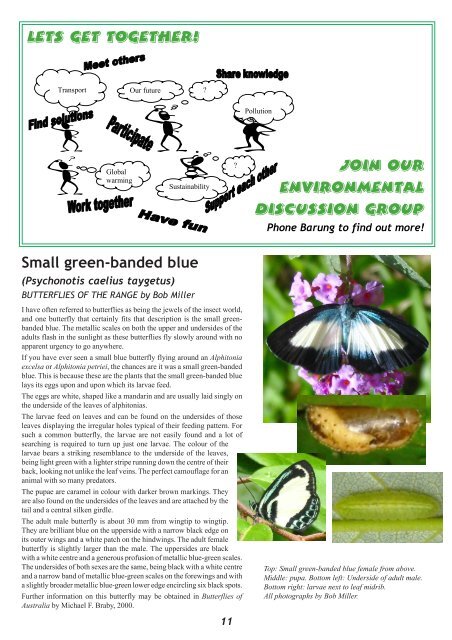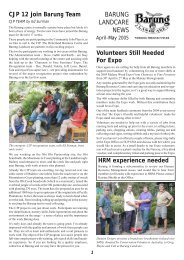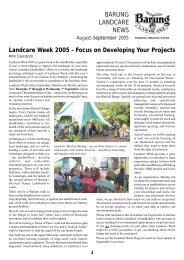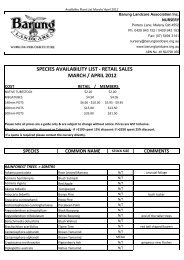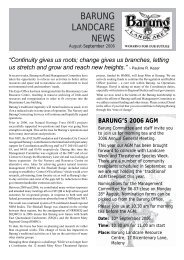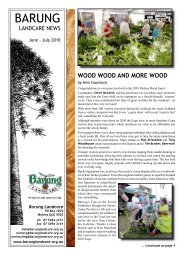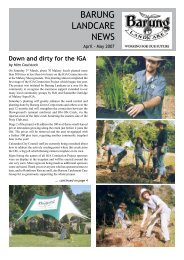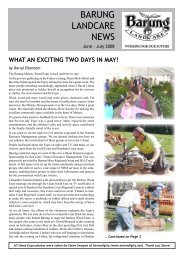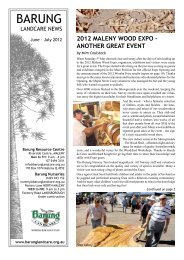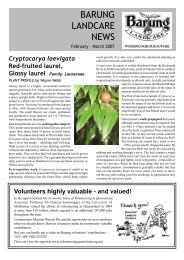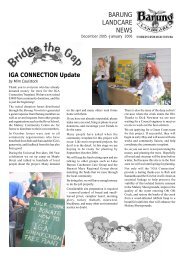Jun/July 2005 - Barung Landcare
Jun/July 2005 - Barung Landcare
Jun/July 2005 - Barung Landcare
- No tags were found...
You also want an ePaper? Increase the reach of your titles
YUMPU automatically turns print PDFs into web optimized ePapers that Google loves.
Lets get together!<br />
Transport<br />
Our future<br />
<br />
Pollution<br />
Global<br />
warming<br />
Sustainability<br />
<br />
Join our<br />
environmental<br />
discussion group<br />
Phone <strong>Barung</strong> to find out more!<br />
Small green-banded blue<br />
(Psychonotis caelius taygetus)<br />
BUTTERFLIES OF THE RANGE by Bob Miller<br />
I have often referred to butterflies as being the jewels of the insect world,<br />
and one butterfly that certainly fits that description is the small greenbanded<br />
blue. The metallic scales on both the upper and undersides of the<br />
adults flash in the sunlight as these butterflies fly slowly around with no<br />
apparent urgency to go anywhere.<br />
If you have ever seen a small blue butterfly flying around an Alphitonia<br />
excelsa or Alphitonia petriei, the chances are it was a small green-banded<br />
blue. This is because these are the plants that the small green-banded blue<br />
lays its eggs upon and upon which its larvae feed.<br />
The eggs are white, shaped like a mandarin and are usually laid singly on<br />
the underside of the leaves of alphitonias.<br />
The larvae feed on leaves and can be found on the undersides of those<br />
leaves displaying the irregular holes typical of their feeding pattern. For<br />
such a common butterfly, the larvae are not easily found and a lot of<br />
searching is required to turn up just one larvae. The colour of the<br />
larvae bears a striking resemblance to the underside of the leaves,<br />
being light green with a lighter stripe running down the centre of their<br />
back, looking not unlike the leaf veins. The perfect camouflage for an<br />
animal with so many predators.<br />
The pupae are caramel in colour with darker brown markings. They<br />
are also found on the undersides of the leaves and are attached by the<br />
tail and a central silken girdle.<br />
The adult male butterfly is about 30 mm from wingtip to wingtip.<br />
They are brilliant blue on the upperside with a narrow black edge on<br />
its outer wings and a white patch on the hindwings. The adult female<br />
butterfly is slightly larger than the male. The uppersides are black<br />
with a white centre and a generous profusion of metallic blue-green scales.<br />
The undersides of both sexes are the same, being black with a white centre<br />
and a narrow band of metallic blue-green scales on the forewings and with<br />
a slightly broader metallic blue-green lower edge encircling six black spots.<br />
Further information on this butterfly may be obtained in Butterflies of<br />
Australia by Michael F. Braby, 2000.<br />
Top: Small green-banded blue female from above.<br />
Middle: pupa. Bottom left: Underside of adult male.<br />
Bottom right: larvae next to leaf midrib.<br />
All photographs by Bob Miller.<br />
11


